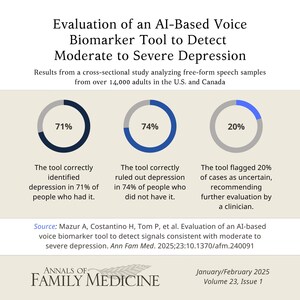ANN ARBOR, Mich., March 28, 2023 /PRNewswire/ -- Momentum has been growing for primary care physicians to provide whole-patient care, which includes addressing their physical and behavioral health needs through team collaboration. Two articles published in the March/April issue of the Annals of Family Medicine identify the characteristics of primary care practitioners and clinics that are more likely to close the gaps on uniting the two aspects of care, as well as a first-person essay that shows how integrated patient care can improve patients' overall health.
Characteristics of Family Physicians Practicing Collaboratively With Behavioral Health Professionals
Research led by Sebastian Tong, MD, MPH, of the University of Washington Department of Family Medicine, scanned questionnaire responses to determine the characteristics of family physicians who work collaboratively with behavioral health professionals. The team cited prior research showing that integrated behavioral health can improve mental health and overall health outcomes, patient care experience, and clinician satisfaction, while reducing health care use and costs.
More than 60% of the 25,222 family practitioners who responded to the questionnaire reported that they did not work collaboratively with behavioral health professionals. Physician characteristics that were significantly associated with increased odds of working with a behavioral health professional included being female and working as core/salaried faculty at an academic institution.
Doctors working in a federal practice site also had a greater likelihood of working with a behavioral health professional. However, primary care clinicians who worked in independently owned practices and were in the southern U.S. were less likely integrating with behavioral health. Working in a county with more psychiatrists was also associated with higher likelihood of behavioral health collaboration.
The authors recommend additional research to better understand why these disparities exist to better integrate behavioral health access for patients.
Integrating Behavioral Health and Primary Care: Turning a Duet Into a Trio
An essay in the same issue of the Annals of Family Medicine provides a first-person account from a primary care provider and a behavioral health professional on how their collaboration benefits patients. Family physician Anne C. Jones, DO, MPH, and behavioral health consultant Kaitlin Lilienthal, Ph.D., document their collaborative approach to helping a patient with health concerns including headache and fatigue that they speculated could be linked to mood and anxiety. Jones describes how she was able to go directly to Lilienthal's office and request that she see the patient same day.
Through this anecdote, the authors described how they were able to bridge the gap and provide more holistic patient care that allows the patient to sidestep barriers including juggling multiple office visits, meeting referral requirements, and resolving insurance issues.
Articles cited:
Characteristics of Family Physicians Practicing Collaboratively With Behavioral Health Professionals, Sebastian Tong, Zachary J. Morgan, Kari A. Stephens, Andrew Bazemore and Lars E. Peterson
Integrating Behavioral Health and Primary Care: Turning a Duet Into a Trio, Anne C. Jones and Kaitlin R. Lilienthal
Related articles in this month's issue:
- Implementing Whole Person Primary Care, by Elena Rosenbaum, MD
- Disparities in Shared Decision-Making Research and Practice: The Case for Black American Patients by Yaara Zisman-Ilani MA PhD
- Patient Satisfaction With Medical Care for Chronic Low Back Pain: A Pain Research Registry Study, John C. Licciardone, DO, MS, MBA
- Patient-Reported Social Risks and Clinician Decision-Making: Results of a Clinician Survey in Primary Care Community Health Centers, Arwen Bunce, MA
SOURCE Annals of Family Medicine

WANT YOUR COMPANY'S NEWS FEATURED ON PRNEWSWIRE.COM?
Newsrooms &
Influencers
Digital Media
Outlets
Journalists
Opted In






Share this article